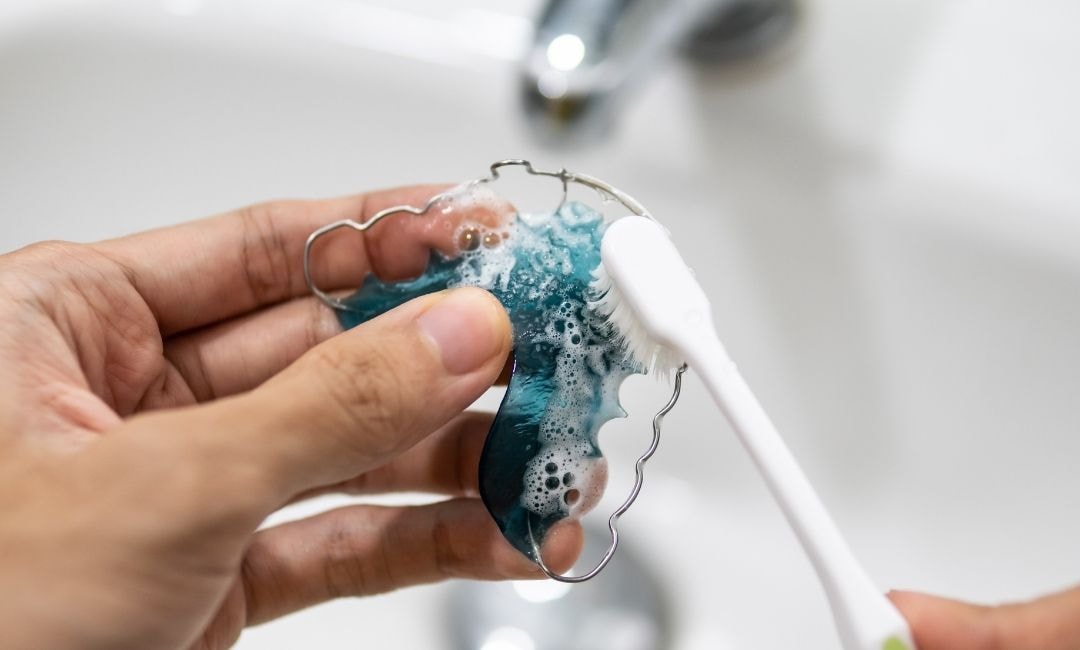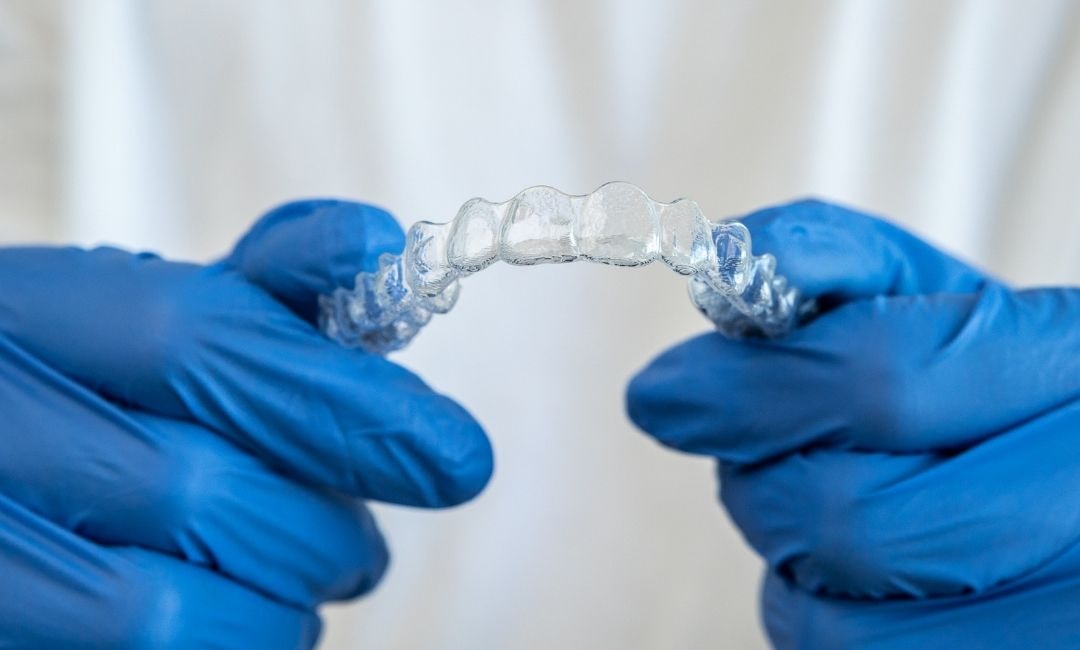How to Clean Retainers: 4 Easy At-Home Methods

Honestly, nobody wants a retainer that looks (and smells) like it's been living under a rock. But keeping those things sparkling clean can be a real challenge. Luckily, we've got you covered with the ultimate guide to retainer care.
In this article, we'll break down the best ways to clean your retainer and banish bad breath for good.
Here's what we'll cover:
- Why retainer hygiene matters
- Common cleaning mistakes to avoid
- Four effective cleaning methods
- Tips for keeping your retainer fresh 24/7
Retainer Basics: What You Need to Know
Retainers work tirelessly behind the scenes to prevent your teeth from shifting back to their old positions. Without retainers, all that time and effort you invested in straightening your teeth could go to waste.
Types of Retainers
- Hawley retainers: These are the classic retainers you probably picture when you hear the word. They're made of acrylic and wire and are removable. Hawley retainers are durable and can be adjusted if needed, but they are the most noticeable type.
- Fixed retainers: These are bonded to the back of your teeth, so you don't have to worry about remembering to wear them. They're great for maintaining the position of your lower front teeth, but they can make flossing a bit trickier.
- Clear retainers: Also known as Essix or Vivera retainers, these are made of clear plastic and are virtually invisible. They're comfortable and easy to wear, but they can be more prone to staining and warping than other types.
- Permanent retainers: While no retainer is truly "permanent," these are bonded to your teeth and can last for many years with proper care. They're a good option for patients who are concerned about compliance with removable retainers.
No matter which type of retainer you have, keeping it clean is crucial. A dirty retainer can harbor bacteria, lead to bad breath, and even affect your oral health.
Why Retainer Hygiene Matters (More Than You Think)
Cleaning your retainer might not be the most exciting part of your day. But trust us, it's a whole lot better than dealing with the consequences of a dirty one.
Think of your retainer as a cozy little apartment for bacteria. If you don't clean it regularly, those microscopic tenants will throw a wild party, leaving behind a grimy mess and a seriously funky smell.
But bad breath is just the tip of the iceberg. Neglecting your retainer can lead to:
- Plaque buildup: This sticky film can harbor bacteria that cause cavities and gum disease.
- Tartar formation: If plaque isn't removed, it can harden into tartar, which can only be removed by a dentist.
- Staining: Certain foods and drinks can discolor your retainer, making it look less than appealing.
- Warping: Exposure to heat or harsh chemicals can warp your retainer, affecting its fit and effectiveness.
- Unpleasant taste: A dirty retainer can leave a bad taste in your mouth, making it less likely you'll wear it as prescribed.
And remember, a poorly fitting retainer can undo all the hard work you put to keep your teeth straight. So, keeping your retainer clean isn't just about fresh breath – it's about protecting your investment and maintaining a healthy smile.
Pro Tip: Pop in a Movemint after brushing. Their unique shape helps seat your aligners and keeps your breath minty fresh. For extra cleanliness, use Movemints Cleaning Tabs daily to kill 99% of bacteria and remove odors in 5 minutes.
Common Retainer Cleaning Mistakes (And How to Avoid Them)
Here are a few common cleaning blunders to avoid:
- Using toothpaste: While toothpaste works wonders on your teeth, it can be too abrasive for your retainer. Those tiny particles can scratch the surface, making it a breeding ground for bacteria.
- Soaking in mouthwash: Mouthwash may freshen your breath, but it won't necessarily kill all the bacteria on your retainer. Some mouthwashes contain ingredients that can discolor or damage certain retainer materials.
- Using hot water: Remember that warping we talked about? Warm water is a surefire way to deform your retainer, making it uncomfortable or even ineffective. Stick to lukewarm or cold water instead.
- Scrubbing too hard: Aggressively scrubbing your retainer can cause scratches and damage. Be gentle.
- Not cleaning regularly: Life gets busy, but that's no excuse for neglecting your retainer. Aim to clean it at least once a day, or more often if you eat or drink anything other than water.
Keep your retainer in its case when you're not wearing it. This will protect it from damage and help prevent it from getting lost.
4 Effective Retainer Cleaning Methods (That Really Work)
Ready to give your retainer the spa treatment it deserves? Here are four cleaning methods for your orthodontic treatment that will banish bacteria and keep your retainer fresh and sparkling:
1. The Classic Soak
This tried-and-true method is one of the easiest ways to clean your retainer.
- What you'll need: A Movemints Cleaning Tab, lukewarm water, and a glass or stainless steel container.
- How to do it: Drop one cleaning tablet into the water and let it fully dissolve. Soak your retainer for at least 5 minutes (or longer for a deeper clean), then rinse thoroughly with cool water.
Bonus: Movemints Cleaning Tabs are also compatible with ultrasonic cleaning systems like Zima for even more effective cleaning.
2. The Brushing Technique
For a more hands-on approach, try brushing your retainer.
- What you'll need: A soft-bristled toothbrush (separate from the one you use for your teeth), lukewarm water, and mild soap (optional).
- How to do it: Wet your toothbrush and gently scrub your retainer, paying attention to all the nooks and crannies. You can use a tiny bit of mild soap if needed, but be sure to rinse thoroughly.
Avoid using toothpaste, as it can be too abrasive for your retainer.
3. The Ultrasonic Cleaning Method
If you're looking for a high-tech solution, consider an ultrasonic denture cleaner.
- What you'll need: An ultrasonic cleaner, lukewarm (not hot or boiling) water, and an ultrasonic cleaning solution (specifically designed for retainers or dentures).
- How to do it: Fill the cleaner with water and solution, place your retainer in the basket, and run the cycle according to the manufacturer's instructions.
Ultrasonic cleaners can be a bit pricey, but they're a great investment if you want a deep clean with minimal effort.
4. The DIY Cleaning Solution
For a natural and budget-friendly option, try a homemade cleaning solution.
- What you'll need: Equal parts water and white vinegar, a container, and a soft-bristled toothbrush.
- How to do it: Mix the water and vinegar in the container, soak your retainer for 15-20 minutes, then gently scrub with a soft toothbrush. Rinse thoroughly with cool water.
Add a few drops of tea tree oil to the solution for its antibacterial properties.
No matter which method you choose, remember to clean your retainer regularly and store it properly when not in use.
Tips for Keeping Your Retainer Fresh 24/7 (Because Nobody Likes Stinky Breath)

You've mastered the art of retainer cleaning, but how do you keep that fresh feeling going all day long? Here are a few extra tips to keep your breath minty and your retainer sparkling:
- Rinse after eating: Whenever you eat or drink anything other than water, give your retainer a quick rinse to remove any food particles and prevent staining.
- Brush and floss regularly: Maintaining good oral hygiene is essential for overall health and for keeping your retainer clean. Brush and floss your teeth thoroughly before putting your retainer back in.
- Carry a travel case: Always keep your retainer in its retainer case when you're not wearing it. This will protect it from damage and prevent it from getting lost (or accidentally ending up in the cafeteria trash can).
- Avoid sugary drinks and foods: Sugar is a feast for bacteria, so try to limit your intake of sugary drinks and snacks. If you do indulge, be sure to rinse your retainer afterward.
- Stay hydrated: Drinking plenty of water helps wash away food particles and bacteria, keeping your mouth and retainer fresh.
- Consider a retainer cleaner: For a deeper clean, try Movemints Cleaning Tabs — individually wrapped, travel-ready, and safe for aligners and retainers.
- Don't forget those Movemints: Pop in a Movemint after brushing and throughout the day for a burst of minty freshness. They're sugar-free, improve oral hygiene, and help your aligners fit better, so you can smile with confidence.
If you notice any persistent bad breath or discoloration, it's a good idea to see your dentist or orthodontist. They can check for any underlying issues and give your retainer a professional cleaning.
Keep Your Smile Sparkling (and Your Breath Fresh)
That's a wrap. You're now officially a retainer-cleaning pro. With these tips and tricks, you can say goodbye to bad breath and hello to a healthy, confident smile.
Just to recap, here are the key takeaways:
- Clean your retainer regularly using one of the popular retainer cleaning methods we discussed.
- Avoid common cleaning mistakes like using toothpaste, dangerous cleaning tablets, or hot water.
- Store your retainer properly when not in use.
- Maintain good oral hygiene and stay hydrated.
Speaking of fresh breath and healthy smiles, have you tried Movemints Mints and Movemints Cleaning Tabs? The mints help your aligners fit better and keep breath fresh, while the tabs give your dental appliance a bacteria-killing, stain-removing deep clean.
FAQs
What is the best way to clean a plastic retainer?
For plastic retainers (like clear aligners), the classic soak with a denture cleaning tablet or retainer cleaning solution is a great option. You can also gently brush with a soft-bristled toothbrush and mild soap. Just be sure to avoid toothpaste and hot water.
How often should you clean retainers?
Clean your retainer at least once a day, or more often if you eat or drink anything other than water.
How to make a retainer not smell?
Regular cleaning is key to preventing retainer odor. Soaking your retainer in a denture cleaning solution or a mixture of water and baking soda can also help neutralize odors.
What to do if retainer is dirty?
Soak your retainer in a denture cleaning solution or a homemade cleaning solution (equal parts water and white vinegar) for at least 30 minutes. Then, gently scrub with a soft-bristled toothbrush.
How to disinfect retainers after being sick?
After being sick, it's important to disinfect your retainer to prevent reinfection. Soak it in a denture cleaning solution or a solution of one part hydrogen peroxide to ten parts water for 15-20 minutes. Rinse thoroughly afterward.
What’s a quick, effective daily cleaner for retainers?
Try Movemints Cleaning Tabs. Just one tab a day removes odors, stains, and bacteria. Pair with Movemints Mints for freshness and improved aligner fit.




